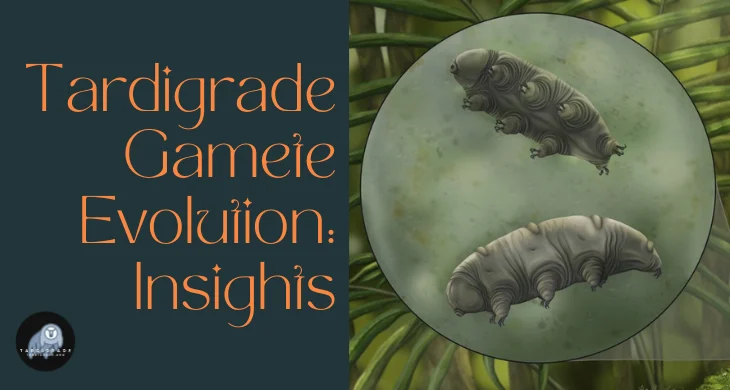Gamete evolution is a journey that takes us into the world of reproductive cells, the very building blocks of life. In the case of Tardigrades, it’s a story of adaptability, diversity, and the remarkable strategies that ensure their continued existence in the microscopic realm.
In this exploration, we will unravel the intricacies of Tardigrade gamete evolution, a tale that offers profound insights into the world of these microscopic creatures. From the unique structures of their sperm to the protective mechanisms of their eggs, we’ll dive into the hidden secrets of Tardigrade reproduction.
The world of Tardigrades is not just about survival; it’s also about thriving in an ever-changing environment. Their gamete evolution is the key to their success, allowing them to adapt to different ecological niches and maintain genetic diversity. As we embark on this journey into the microscopic world of Tardigrades, we discover that even in the tiniest corners of nature, there are stories waiting to be uncovered, and the evolution of Tardigrade gametes is one such captivating narrative.
Tardigrades, those microscopic marvels known for their resilience, have a lot more to offer than just their survival skills. In the world of reproduction, these tiny creatures unveil a captivating story of gamete evolution. Join us as we embark on a detailed exploration of Tardigrade gamete evolution and the intriguing insights it provides into their microscopic realm.
Gamete Evolution
In Tardigrades Gametes are reproductive cells – sperm and eggs – that play a crucial role in the reproduction of many organisms. In the case of Tardigrades, their gamete evolution is a story of adaptability and diversity.
Tardigrade Reproductive Strategies Tardigrades are known for their flexible reproductive strategies. While some species reproduce asexually through parthenogenesis (the development of embryos without fertilization), others engage in sexual reproduction, where two gametes – a sperm and an egg – combine to create offspring. This diversity in reproductive strategies allows Tardigrades to adapt to different environmental conditions.
Sperm in Tardigrades Tardigrade sperm is unique in many ways. It often has a coiled or spiraled structure, which is thought to help with penetration and fertilization. The variation in sperm structure among different Tardigrade species hints at their ability to adapt and evolve their reproductive mechanisms.
Eggs and Reproduction Tardigrade eggs are equally fascinating. They are often enclosed in a protective envelope that shields them from environmental threats. The diversity in egg structure and protective mechanisms reflects Tardigrades’ adaptability to different habitats and the challenges they face.
Gamete Evolution and Genetic Diversity The evolution of Tardigrade gametes plays a vital role in maintaining genetic diversity within the population. By evolving unique reproductive strategies, Tardigrades can adapt to different ecological niches and ensure the survival of their species in diverse environments.
Unraveling the Mysteries of Tardigrade Reproduction The study of gamete evolution in Tardigrades is an ongoing scientific journey. Researchers continue to explore the intricate details of their reproductive mechanisms, shedding light on the complexities of life in the microscopic world.
From Resilience to Reproduction Tardigrades, with their gamete evolution and adaptability in reproduction, showcase that life in the microscopic realm is far from simple. Their story takes us from their renowned resilience in the face of adversity to the fascinating world of reproduction. It’s a testament to the diverse and incredible adaptations that life can undertake, even on the smallest scale.
As we delve deeper into Tardigrade gamete evolution, we gain a richer understanding of the remarkable and often hidden intricacies of life in the microcosm. Tardigrades continue to inspire us to explore the mysteries of the microscopic world, reminding us that even in the tiniest corners of nature, there are profound stories waiting to be uncovered.
FAQS:
Q1: What is gamete evolution in Tardigrades?
A1: Gamete evolution in Tardigrades refers to the development and adaptation of their reproductive cells (sperm and eggs) over time. It plays a crucial role in their reproduction and adaptability.
Q2: Do Tardigrades reproduce sexually or asexually?
A2: Tardigrades employ various reproductive strategies. Some species reproduce asexually through parthenogenesis, while others engage in sexual reproduction, involving the fusion of sperm and eggs.
Q3: How do Tardigrades ensure genetic diversity in their population?
A3: Tardigrades maintain genetic diversity through their various reproductive strategies. Sexual reproduction allows for genetic recombination, while asexual reproduction ensures rapid population growth.
Q4: What makes Tardigrade gametes unique?
A4: Tardigrade gametes are unique in their structures. Tardigrade sperm often has a coiled or spiraled form, while their eggs are enclosed in protective envelopes to shield them from environmental threats.
Q5: What is the significance of studying Tardigrade gamete evolution?
A5: Studying Tardigrade gamete evolution provides insights into the reproductive adaptations of these remarkable microorganisms. It helps us understand their adaptability to different environments and their role in maintaining genetic diversity.
Conclusion:
The evolution of gametes in Tardigrades plays a pivotal role in their survival and adaptability. Tardigrades exhibit diverse reproductive strategies, ranging from sexual reproduction with unique sperm structures to asexual parthenogenesis, allowing them to adapt to a wide array of environmental conditions.
Asexual and Sexual Reproduction Tardigrades’ capacity for both asexual and sexual reproduction is a testament to their adaptability. Asexual reproduction ensures rapid population growth, while sexual reproduction maintains genetic diversity within their population.
Sperm and Egg Uniqueness Tardigrade sperm, often characterized by coiled or spiraled structures, highlights their innovative approach to fertilization. Their eggs, encased in protective envelopes, showcase adaptations for shielding against environmental threats. These unique features enable them to navigate their microscopic world with precision.
Hidden Secrets and Scientific Inspiration The study of Tardigrade gamete evolution is a journey of discovery and inspiration. It unravels the hidden secrets of life at the tiniest scales and showcases the incredible diversity of adaptations that can occur, even within the smallest corners of nature.
Beyond Gamete Evolution Tardigrades, with their gamete evolution, remind us of the boundless potential for discovery in the natural world. They inspire scientific exploration not only by shedding light on their reproductive adaptations but also by providing insights into life’s adaptability in extreme environments. Their significance extends to fields such as astrobiology, biotechnology, and environmental studies, emphasizing their broader role in scientific research.
The Ever-Evolving Story As we conclude our journey into the world of Tardigrade gamete evolution, we recognize that their story is far from over. It’s an ever-evolving narrative of adaptation and survival in the microscopic realm, where every revelation sparks new questions and inquiries. Tardigrades continue to inspire us to explore the hidden intricacies of life on Earth and, perhaps one day, even beyond.

